- Author Miguel Ramacey [email protected].
- Public 2023-12-17 06:11.
- Last modified 2025-01-24 21:21.
On the cape formed by the floodplains of the Babarynka and Tura rivers, the first Holy Trinity Monastery in Tyumen was founded at the beginning of the 17th century. It is known as one of the oldest and most beautiful architectural ensembles in Siberia. Closed during the years of atheistic hard times and thus sharing the fate of most Russian monasteries, the monastery was revived only thanks to the trends of the new post-communist times.
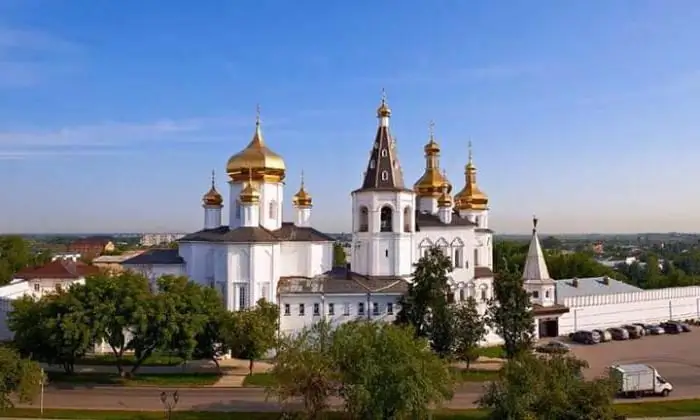
Good deed of Elder Nifont
The first mention of the Tyumen Holy Trinity Monastery is contained in a letter dated 1621 and sent from the Kazan order, which was then one of the highest state bodies of Russia, to the Siberian governor. In it, the clerk reports that, according to his information, five years earlier, a certain elder Nifont founded a monastery in Tyumen, and chose a river cape not far from Yamskaya Sloboda as a place for it.
This message is limited, but for all itsstinginess allows us to establish with the utmost accuracy the year of foundation of the Holy Trinity Monastery, which during the first century of its existence was called the Transfiguration Monastery of the Savior. This happened because the first wooden church erected in 1622 on the territory of the monastery was consecrated in honor of one of the most important biblical events, which was the Transfiguration of the Lord. Its creator was master Kornely Khorev.
Begin construction of the monastery
History has preserved for us the names of other builders, such as monk Iona Likharev, who had previously taken tonsure in the famous Kirillo-Belozersky monastery, and Elder Onufry, a native of the Novgorod Anthony monastery. Brotherly cells and some outbuildings were erected by their own efforts.
The first abbot of the monastery, hegumen Abraham, who arrived in Tyumen from Rostov the Great, blessed the builders for this charitable work. An important role in the development of the monastery was played by the patronage provided to it by Tsar Mikhail Fedorovich. At his command, the monks were assigned a ruga, a cash allowance paid by the treasury, and extensive fishing was provided.
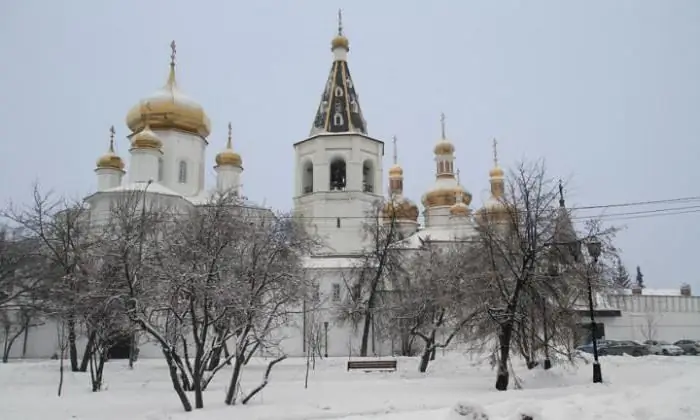
Building a new temple
In 1705, a strong fire broke out in Tyumen, which engulfed the entire city and destroyed most of the buildings. The only monastery church was also destroyed in the fire. The people of Tyumen, taught by bitter experience, turned through their Metropolitan Philotheus (Leshchinsky) to Peter I with a request to allow them, contrary to the existing ban, to build on the site of the burned-out HolyChurch of the Transfiguration stone temple. The problem was that the sovereign decree in those years was allowed to build stone structures only in the young capital of the state - St. Petersburg and several other cities, of which Tyumen was not included.
The highest permission was received, and in 1708, the construction of a stone church began on the territory of the monastery with the funds collected by the whole world. The work, which was directly controlled by the same Metropolitan Philotheus, continued for seven years, and upon completion of the new church was consecrated in honor of the Holy Trinity, which is why the monastery from then on became known as the Holy Trinity Monastery of Tyumen.
Further expansion of the monastery
It is curious to note that this pious Philotheus, after the completion of construction, left the metropolitan chair he occupied and, having accepted the schema, intended to spend the rest of his life within the walls of the monastery patronized by him, but he could not stay in idleness for a long time. Resuming his hierarchical service two years later, he initiated the construction of another stone church on the territory of the monastery, this time consecrated in honor of St. Zosima and Savvaty.

When in 1722 the sovereign lifted the ban on the widespread construction of stone structures in Russia, the Tyumen bishop initiated the construction of another stone monastery church in honor of Peter and Paul. Work on it was unreasonably delayed and ended only three decades after his death, which followed in 1727. Simultaneously with the templeperiod, the building of the rector's building was built, and the stone walls surrounding the monastery were erected. However, these works were carried out very slowly and, begun in 1724, stretched out for 15 years.
Monastic life in the 18th and 19th centuries
A document of the 18th century, called the “Spiritual State”, has been preserved, according to which, due to the small number of brethren, the Holy Trinity Monastery (Tyumen) at that time was assigned to the lowest, third class. However, this did not prevent him by the middle of the next century from taking a place among the best monasteries in Siberia, standing on a par with such famous monasteries of Irkutsk as Innokentievsky and Voznesensky.
In 1842, Tyumen was engulfed by the second terrible fire in its history, which also caused incalculable damage to the city. Of the monastery buildings, the church of Peter and Paul suffered the most. It had to be rebuilt, which led to some distortion of the original appearance. Nevertheless, after the restoration, he continued to be among the city's architectural landmarks.

On the threshold of dark times
Thus, having counted three centuries of its history, the glorious monastery came to the tragic events of 1917. Less than a year after the perfidious seizure of power by the Bolsheviks, their government issued a decree, on the basis of which, in January 1923, the Holy Trinity Monastery (Tyumen), the address of which was then well known not only to the God-loving townspeople, but also to many pilgrims who came from different cities of the country, was abolished.
However, innovations then touched all aspects of life. In particular, Communist Street appeared on the city plan, formerly called Bolshaya Monastyrskaya and approached the very gates of the once prosperous, but now devastated, but, fortunately, not destroyed monastery.
The period of destruction of the monastery
Decades that followed after the closing of the monastery can be called the period of his "going through the torments". However, such a definition is quite consistent with the historical path of all of Russia after its “God-bearing people” came to power, as Leo Tolstoy naively called it.
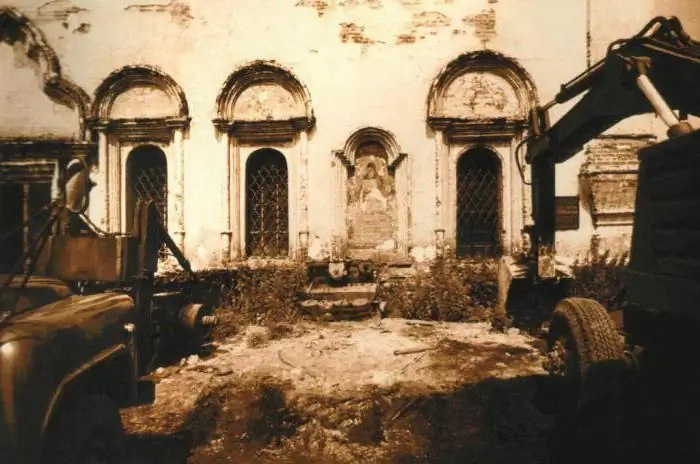
In the early years, the rectory building, as well as a number of other monastic buildings, were given to accommodate materials from the provincial archive. Further, on the territory of the former monastery, they tried to create a complex of objects of cultural and mass purpose, and since Soviet culture was incompatible with religious dope (an expression used by militant atheists), they, without hesitation, destroyed a valuable historical monument - the grave of Metropolitan Philotheus (Leshchinsky), about the good undertakings of which was described above. His remains, taken from the burial, were transferred to the city anti-religious museum, located in the premises of the Annunciation Cathedral, also abolished and blown up in the summer of 1932 by decision of the city party organization.
The years of the war and the period of subsequent economic recovery
After the Nazi attack on our country, the entire territory of the former Holy Trinity Monastery was transferred to the headquartersTyumen garrison to accommodate military personnel who were trained before being sent to the front. However, the years of war hard times did not cause as much damage to the monastery as the period of peaceful life that followed them.
In 1946, the city needed treatment facilities, and for their construction the authorities allocated a site on the territory of the former monastery, for which they had to blow up three churches that had survived until that time: Peter and Paul, Zosima and Savvaty, as well as erected in honor of Bogolyubskaya icons of the Mother of God. A photo of the monastery, taken in those dark years, is given above.
The monastery, once famous for its beauty, was saved from complete destruction only by the decree of the Council of Ministers of the RSFSR "On the protection of architectural monuments." In 1949-1950. the city authorities carried out a major overhaul, and after another 10 years the monastery, or rather, everything that was left of it, was transferred to the regional department of culture.
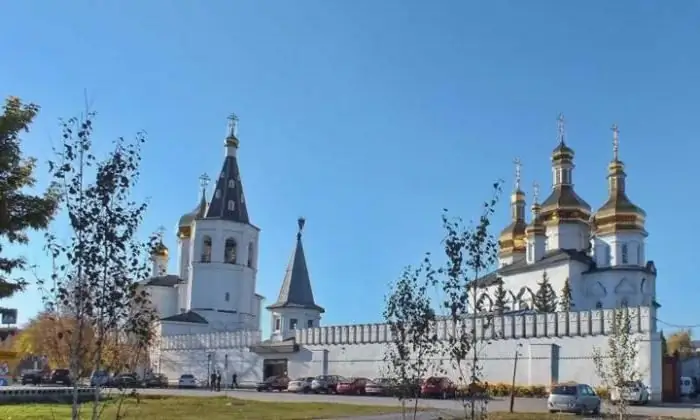
The first rector of the revived monastery
The true revival of the monastery began only with the beginning of perestroika. In 1995, the then archimandrite, and now Bishop Tikhon (Bobov), was appointed its rector. I would like to dwell on the personality of this person, since he made an invaluable contribution to the formation of the spiritual life of modern Tyumen.
Born on September 12, 1954 in Pervouralsk, Viktor Dmitrievich Bobov (this is his full name) early felt a craving for religion, and upon reaching the age of majority he accepted holy baptism. However, in those years he did not yet think about dedicatingserving God all his life, and in 1973 he entered the veterinary technical school, and after graduation he became a student at the Moscow Veterinary Academy.
Having received a diploma, Viktor Dmitrievich worked in one of the research institutes of the capital and in 1989 he defended his doctoral dissertation. A promising scientist was predicted to have a brilliant career, but unexpectedly for everyone, he took monastic vows with the name he took in honor of St. Tikhon of Zadonsk. From this period began his selfless service to the Church. The future Bishop Tikhon passed all stages of growth with honor, starting as an ordinary monk and in 2013 donning the hierarchal mantle. His photo is shown below.
The main shrines of the monastery
In 1996 the Holy Trinity Monastery (Tyumen) was finally returned to the Church. After a number of restoration and restoration works, carried out with the direct participation of its rector, Archimandrite Tikhon, in June 2003, the first divine service after many decades of "darkness and desolation" was performed. Since then, the revived monastery has again become one of the leading spiritual centers not only in Tyumen, but throughout Siberia.
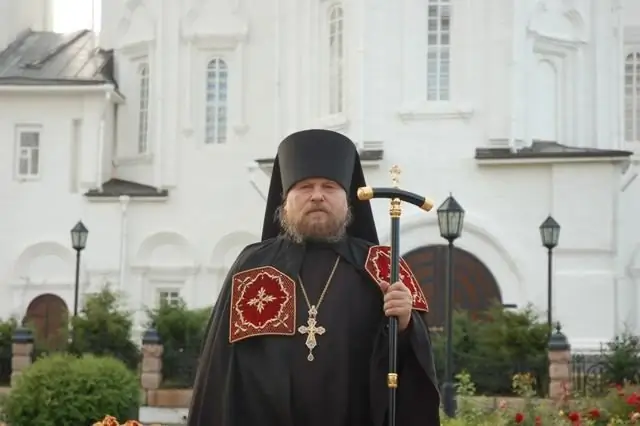
The icons of the Holy Trinity Monastery are especially honored by believers, among which the Jerusalem image of the Mother of God stands out. His monastery received a gift from the Orthodox pilgrimage community of Israel, whose delegation visited Tyumen in 2000. Made and consecrated in the Holy Land, it is a blessing received from the Jerusalem Patriarch Theophilus.
Otherno less revered shrine are the relics of St. Philotheus, who in the days of his earthly life was the Metropolitan of Tobolsk. His imperishable relics, once desecrated by the Bolsheviks, as described above, were miraculously found in 2006 and now rest in the Holy Trinity Cathedral of the monastery.
In addition, many pilgrims who come to the Holy Trinity Monastery, located at Tyumen, st. Communist, 10, rush to bow to the Cross with a particle of the Life-Giving Tree of the Lord, as well as the miraculous icon of the Hieromartyr Hermogenes, Bishop of Tobolsk. These two shrines are also kept within its restored walls.






